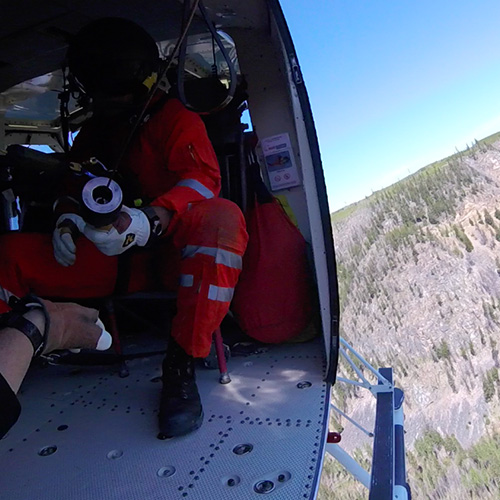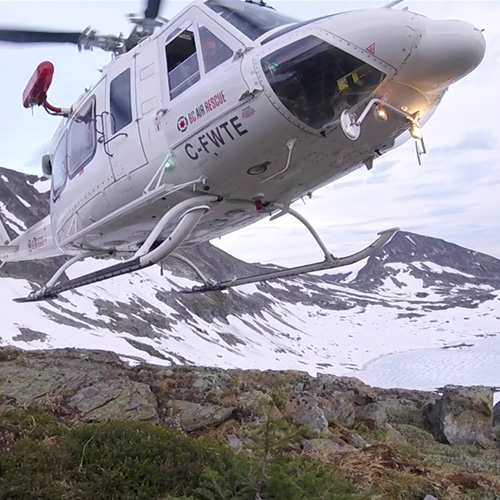What We Do
When someone calls 911 for a rescue, the current procedure requests a ground evacuation when possible. In mountain-related accidents such as climbing, skiing (backcountry), paragliding and trekking, a ground evacuation is often impossible due to the remoteness and the complexity of the terrain. Lack of road access could dramatically transform a common injury into a life threatening situation. In those cases, there is a critical need for a helicopter rescue. When our team is called to go perform a rescue, we are ready and flying in less than 5 minutes after initial call.
When arriving on the accident site, we first localize the person needing to get evacuated and then proceed with our evacuation protocol. If it is unsafe to land, we will then hover and deploy our Paramedic Rescue Technicians to the ground with a winch. Once the Rescue Technician has reached, assessed and stabilized the patient we proceed with an adaptive evacuation. If the patient suffers from lower body, or arm injuries, our medical crew will secure and extract the patient with the use of a full body harness. When spinal injuries may have occurred, the patient can then be air lifted with the use of a specifically designed basket.
With highly qualified paramedics onboard, we can provide the best level of patient care while en-route to the nearest hospital. After the patient is taken care of at the hospital, we then fly to our next mission.

Program Advantages
In addition to being able to perform rescues in remote wildland, the quality and speed at which BC Air Rescue can access an incident location means the patient can receive first treatment within the “golden hour”. Brining advanced prehospital care within the hour greatly increases the chances of survival while reducing the downstream medical costs.
Making use of our emergency rescue service enables other rescue operating teams such as ground ambulances and Kamloops Air Dispatch to use their resources more efficiently.
Health professional agree that immediate and well administered medical care results in shorter hospital stays. This leads to a freeing up of hospital resources, resulting in significant decrease in post hospital recovery and care costs.
Service Area
Equipped with a specially designed Bell 412 helicopter, BC Air Rescue has a service range of 720 km from our West Kelowna air base. The map below illustrates the extend of our service area.

Equipment
The primary helicopter for use in search rescue is a modified Bell 412 Helicopter.
Bell 412 Specifications
| Aircraft: | Bell 412 (Mod) |
| Speed: | 240 km/hr |
| Endurance: | 3.0 hrs |
| Range: | 720 km |
| Crew: | 1 Pilot, 1 Rescue Winch Operator Paramedic, 2 Rescue Technician Paramedics |
| Configured Seating: | 9 |
| Patient Capacity: | 2 |
| Landing Zone: | 25 meters diameter or typical dual carriageway road |
| Cable Length: | 250 ft |
| Winch Cable load max: | 600 lbs (2ppl) |
| Cable Speed: | 250ft/min |
| Variable speed winch | Yes |
| Life support equipment: | Standard in all aircrafts |
| Protocols: | Land first, if unable to land then hover exit, if unable to hover, exit Winch deployment and extraction |
Contact Us
2431 Dominion Rd.
Kelowna, B.C.
Canada
V1Z 2Y4
Telephone: (24/7): 1.250.769.9093
Fax: 1.250.769.9053
For all business or contract enquires please contact:
Ian Wilson – Vice President
ian@wildcatheli.com
Other Contacts
Mike Michaud – President
Dave Hauber – Chief Pilot
